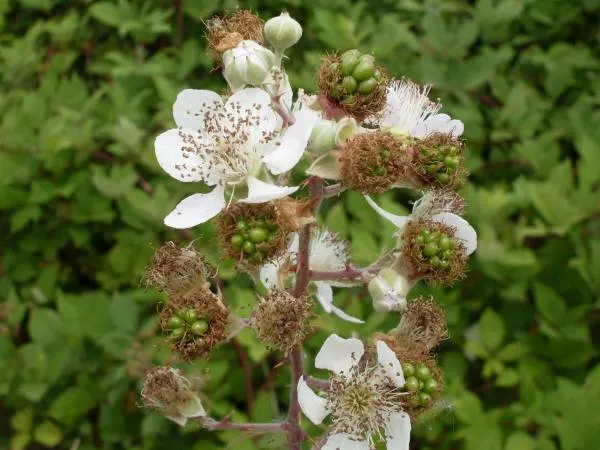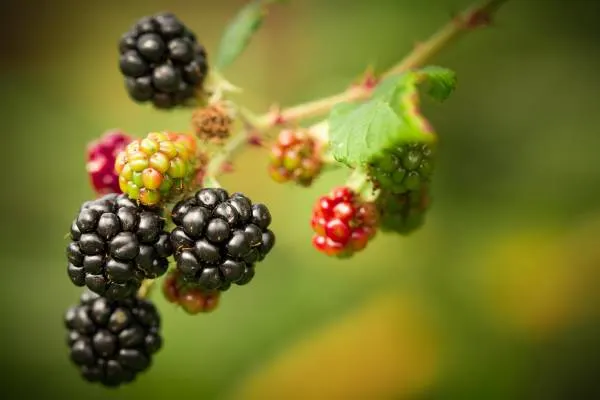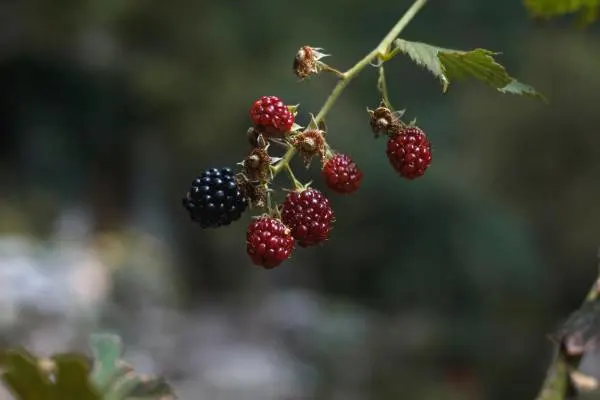Blackberry is a nature’s treat.
It’s sweet and versatile!
You can turn it into tasty jams, refreshing juices, or yummy pies.
And let me tell you, nothing is more satisfactory than enjoying something you’ve grown yourself in your beautiful garden. Just think for a second how lovely it seems to have a snack aisle right outside your door.
When you plant and care for your blackberry bushes, it’s not just about having delicious berries but also about creating a vibrant and sustainable environment that attracts different animals to your garden.
However, we are here to talk all about blackberries blooming!
If you are curious about it, there is no need anymore.
Let’s begin!

When Do Blackberries Bloom?
Blackberries typically bloom in late spring to early summer, usually between May and July.
The plants produce small, white, or pink flowers that eventually turn into berries during this time.
From the first blooms, it takes 60 to 70 days for the berries to ripen, with clear signs like size growth and color change from green to red to deep black.
The harvesting season extends from mid-June to early October.
However, the exact timing can vary based on the specific type of blackberry and the local climate. Keep an eye out for these blossoms as they signal the beginning of the fruiting season.
Once the flowers appear, it won’t be long before you can enjoy delicious blackberries.

The Blackberry Plant Life Cycle
The life of a blackberry plant, from seed to harvest, is a captivating story of growth and transformation.
Let me simplify this enchanting journey for you.
- First, the blackberry plant starts as a tiny seed.
- Once planted, it sprouts and grows into young plants, eventually becoming the sprawling blackberry bushes we see in gardens or farms. That marks the initial stage of the blackberry plant’s life.
- Moving on to the second stage, we focus on the bloom. It is when the blackberry plant decorates itself with delicate and often fragrant flowers of tiny white or pink blossoms. The bloom stage is crucial as it starts the plant’s fruit-bearing journey.
- After successful pollination, the fertilized flowers develop into berries.
- Blackberries are aggregates of drupelets, each containing a seed.
- The small green berries grow and mature over time. As the berries ripen, they change color from green to red and finally to a deep, dark purple or black, depending on the variety. The blackberries continue to ripen until they reach their full, mature color and flavor.
- Harvesting is typically done when the berries are plump, juicy, and easily separated from the plant.
Note: The emergence of beautiful blooms varies depending on the specific blackberry cultivar and environmental conditions, like temperature, soil conditions, and sunlight.
Consequently, the timing of harvest can vary accordingly.

Blackberry Varieties and Their Blooming Periods
Blackberries are tasty fruits that come in different varieties.
Each variety has unique features, like taste, size, blooming, and harvesting periods.
Here are some common types of blackberries and their blooming periods:
Prime-Ark Freedom
- Blooming Period: Late spring to early summer.
- Ripening Period: Summer to early fall.
- Harvesting Period: Summer to early fall.
Triple Crown
- Blooming Period: Late spring.
- Ripening Period: Mid to late summer.
- Harvesting Period: Mid to late summer.
Navaho
- Blooming Period: Late spring to early summer.
- Ripening Period: Mid to late summer.
- Harvesting Period: Mid to late summer.
Chester Thornless
- Blooming Period: Late spring.
- Ripening Period: Late summer to early fall.
- Harvesting Period: Late summer to early fall.
Natchez
- Blooming Period: Late spring to early summer.
- Ripening Period: Early to mid-summer.
- Harvesting Period: Early to mid-summer.
Ouachita
- Blooming Period: Late spring to early summer.
- Ripening Period: Mid to late summer.
- Harvesting Period: Mid to late summer.
When cultivating blackberries, you must monitor local conditions and consult experts for specific guidance on your region’s blooming, ripening, and harvesting periods.
Environmental Factors Affecting Blackberry Bloom
Blackberry plants (Rubus spp.) are influenced by various environmental factors during their blooming period.
Here are some key environmental factors that affect blackberry blooms:
Temperature Affects on Blackberry Blooms
Blackberry plants often require a certain number of chilling hours during winter to break dormancy and promote healthy bloom in the spring. Lack of sufficient chilling hours can delay or reduce blooming.
Here’s a credible source that mentions the ideal chilling requirements for different types of blackberries (PDF).
Adequate heat units during the growing season are essential for proper blackberry development. Extreme temperatures, either too high or too low, can negatively impact the bloom.
Lighting Affects on Blackberry Blooms
Blackberries are sensitive to day length, and the duration of daylight influences their flowering.
Some blackberry varieties require a specific photoperiod to initiate and maintain bloom.
Insufficient light can reduce photosynthesis and energy production, affecting bloom and fruit development.
Soil Conditions
Consistent and well-distributed soil moisture is crucial for blackberry bloom.
Water stress from drought or excessive watering can impact flower initiation and development.
Blackberries prefer well-draining soil with a slightly acidic to neutral pH. Soil that is too compacted or has extreme pH levels can hinder nutrient uptake and affect bloom.

Primocane-Fruiting Vs. Floricane–Fruiting Varieties
Blueberries are classified into two main types based on their fruiting habits:
- Primocane-fruiting
- Floricane-fruiting
These terms refer to when the plants produce fruit and can impact the timing and quantity of the harvest.
Primocane-Fruiting Blueberries
Primocane-fruiting blueberries are a relatively newer development in blueberry breeding.
Unlike floricane-fruiting varieties, primocane-fruiting blueberries produce fruit on canes that have grown during the current season, but they also produce fruit on the previous season’s canes, resulting in two crops per year.
Primocane-fruiting varieties offer the advantage of an extended harvest season, but they also have some disadvantages, such as higher susceptibility to diseases, pests, frost, and drought.
These varieties are often more forgiving in terms of pruning.
While some growers may choose to prune to manage plant size or shape, primocane-fruiting blueberries can be left unpruned and will still produce fruit on the new canes.
Floricane-Fruiting Blueberries
Most blueberry varieties fall into this category.
Floricane-fruiting blueberries produce fruit on wood that grew during the previous growing season.
This wood is referred to as “floricanes.”
To maintain productivity, these varieties require proper pruning.
Dead or unproductive wood is removed annually to encourage the growth of new canes that will bear fruit the following year.
Floricane-fruiting varieties typically have a specific harvest season, usually in the summer.
Choosing between primocane-fruiting and floricane-fruiting varieties depends on factors such as the desired harvest season, local climate, and the grower’s preferences for pruning and management practices.
Primocane-fruiting blueberries offer the advantage of a more extended harvest period. At the same time, traditional floricane-fruiting varieties may be preferred for their established characteristics and management practices.
That’s all for today!
Now, it’s time to move toward the conclusion.
Conclusion
Growing blackberries means having a tasty treasure in your backyard.
These sweet berries bloom from late spring to early summer, with harvest time stretching from mid-June to early October. As your blackberry plants go from tiny seeds to sprawling bushes, they decorate themselves with delicate flowers before transforming into delicious berries.
The journey from seed to harvest is fascinating and depends on factors like temperature, soil, and light.
Remember, different types of blackberries, like Prime-Ark Freedom and Triple Crown, have their own blooming periods.
Plus, some also bloom on new canes, giving you two harvests a year!
I hope this article helps you a lot.
If this article really means something to you, don’t forget to share it with your friends.
Regards,
Moiz Atiq.
